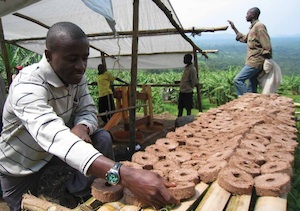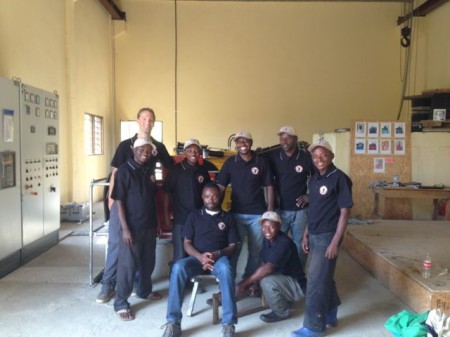Green energies to preserve a World Heritage site
Parc national des Virunga est situé au cœur du conflit, et chevauche la frontière entre la RDC, Rwanda et l'Ouganda. Accueil à certains des derniers au monde gorilles de montagne restants,c'est l'Afrique le premier parc national, a World Heritage Site and is known to contain more species ofmammals, les oiseaux et les reptiles que toute autre zone protégée sur la planète.
Au lendemain du génocide rwandais, 15 années de conflits violents dans l'est du Congo produites l'une des pires tragédies humanitaires de l'histoire récente. Conflits sur les ressources naturelles est une cause sous-jacente du conflit armé. Le trafic illégal des ressources forestières, en particulier de charbon de bois, provided armed groups with one of their primary sources of income. Au cours 70,000 tons of charcoal is illegallyproduced every year. Thisrepresents the destruction ofover 15,000 hectares of tropicalhardwood forest.
La production de briquettes:
une source alternative de carburant autour des Virunga
A 2008 study of the charcoal market in Goma by the African Conservation Fund estimated that 59,000 tonnes were consumed each year, with 80% coming from Virunga.
In these circumstances, the Village Briquette Factories project provided a viable solution to replace the consumption of charcoal in the region with a viable and sustainable alternative, empêchant ainsi la destruction massive des forêts des Virunga. Combustible biomass briquettes are an ecologically sustainable fuel source available to households living in extreme poverty. They aresignificantly cheaper than charcoal and can be produced from a verywide range of abundant resources including grass, leaves, agriculturalwaste, sawdust and recycled paper.
The expected impact of the project should be of 34,000 sustainable employments. Des kits complets d'usine, comprenant l'équipement nécessaire, entraînement, support et une garantie d'achat de la production seront remis à 5,000 équipes de 6 personnes. Les producteurs de briquettes peuvent générer suffisamment de revenus pour soutenir leurs familles dans les 10 jours de leur formation de 2 jours.
Durablement le financement du parc national des Virunga. The Village Briquette Factories will be developed as a high yielding business model. Les bénéfices seront en partie réinvestis pour développer davantage le programme, et en partie utilisée pour couvrir une part importante des coûts de fonctionnement du Parc national des Virunga.
The project is complementary to another project started by WWF in 2008, aimed to tackle illegal charcoal production in Virunga in ways that would benefit local people. It has established local production of efficient stoves to cut the use of charcoal, and helped to start small plantations to supply wood for charcoal production on a sustainable basis.
This project is a true model of international cooperation. The pilot programme for the Village Briquette Factories was funded by the European Union, The African Conservation Fund (Royaume-Uni) the US Fish and Wildlife Service, theBritish Foreign and Commonwealth Office, the Daey Ouwens Fund, the Belgian Ministry of Foreign Affairs, UNESCO/Région Wallone, Government of Germany, the World Wide Fund for Nature (UNESCO’s actions on climate change mitigation and adaptation), the Greater Virunga Transboundary Collaboration/government of the Netherlands and several private donors.
Hydro power to develop Virunga
A hydro-electric project using water run-off from the park’s Ruwenzori Mountains has been finalised in 2013. This has allowed Virunga to have an electricity grid for the first time.
The facility has an installed capacity of 400 kW to serve the people of Mutwanga near Virunga’s northern sector headquarters, and has the potential for increased economic development in the region and start ensuring access to electricity. The revenue that will be generated by the Mutwanga hydroelectric plant is also a big first step on the path toward helping the park fund operations even when tourism is closed by conflict.
Canada
The implementation of an arduous campaign was central to the success of the Briquettes Programme. En 2009 there were 500 presses in production, generating over 4000 sacks of briquettes a month, with over 3000 people involved in that production. Assembling a team of trainers and business advisors, and build a very effective logistics, finance and administrative support system were necessary to drive the project forward.
The creation of the Renewable Energy and Efficient Technology Center has been a major supporting measure. A growing number of businesses and households are turning away from charcoal as a result.

















